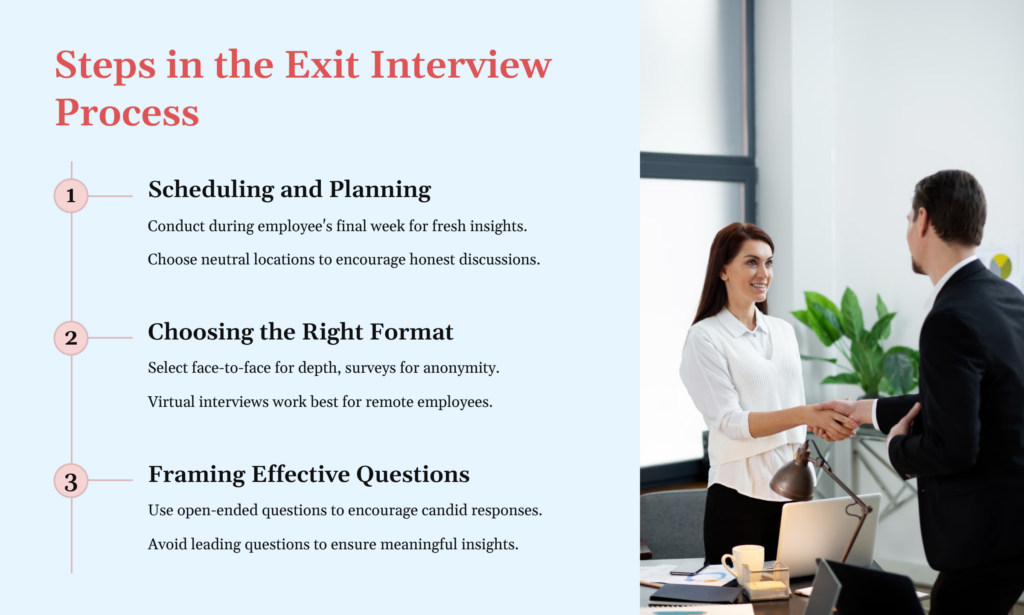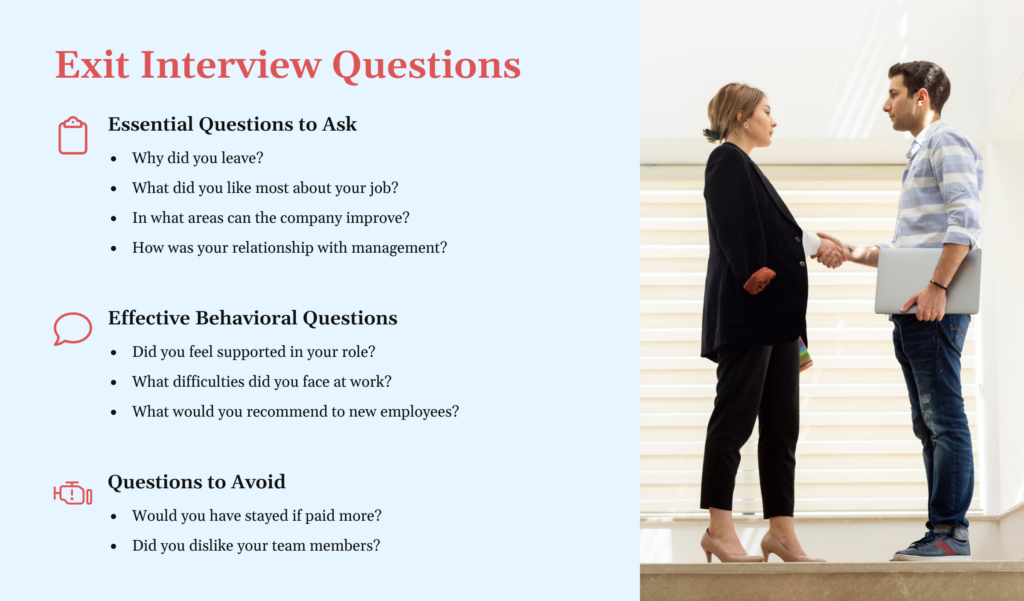The Ultimate Guide to Exit Interviews: Process, Questions, and Purpose


Quick Summary
- Exit interviews help organizations understand why employees leave, improve workplace policies, and enhance retention strategies. They foster transparency and strengthen company culture.
- A structured approach includes selecting the right format, ensuring confidentiality, and asking open-ended questions. Avoiding bias and acting on feedback increases effectiveness.
- Analyzing trends, implementing changes, and using exit surveys or post-exit follow-ups help improve employee satisfaction and reduce turnover.
Table of Contents
An exit interview is one of the essential keystones of the employee life cycle. It gives organizations a snapshot of why employees leave and how they can improve their workplace. It enables HR professionals to identify trends, fix workplace problems, and improve retention strategies.
Exit interviews are used to gain honest feedback, improve workplace culture, and enhance employee satisfaction. A well-designed interview process ensures that departing employees give constructive feedback while feeling heard and respected.

This guide will explore an exit interview and provide best practices and actionable insights on using interview feedback effectively to benefit employees and organizations.
What is Exit Interview?
An exit interview is an official conversation between the employer and an employee leaving the company, usually conducted by the HR department. The primary goal is to determine why the employee leaves and what can be improved in the organization.
These interviews allow employees to provide honest comments regarding their experience in the firm, allowing the company to gain insight into workplace culture, management performance, and job satisfaction. They aim to create a balance in the environment to benefit current and future employees.
The Purpose of Exit Interviews
An exit interview is designed for far more than merely a desire to learn why an employee leaves:
- Identifying repeat workplace issues and areas of improvement.
- Gathering data on company culture and management effectiveness.
- Strengthening employer branding by demonstrating a commitment to feedback.
- Creating better retention strategies to reduce future turnover.
Organizations with formal interview programs will likely experience greater employee satisfaction and lower turnover. By reading feedback and making changes as necessary, organizations foster a more positive work environment, which improves overall employee morale and productivity. Real-world applications show that businesses that act on exit interview feedback are more likely to create a culture of continuous improvement, making them more attractive to current and potential employees.
Understanding the Exit Interview Process
An exit interview is a crucial step in the employee offboarding process. It provides valuable insights into workplace culture, management practices, and areas for improvement. A well-structured interview process ensures that departing employees feel heard, enabling organizations to refine their retention strategies.
Steps in the Exit Interview Process
An effectively designed exit interview process guarantees feedback that is relevant and actionable. The following are the essential steps:

1. Scheduling and Planning the Interview-Conducting the interview during the employee’s final week ensures updated and relevant feedback. Choosing a neutral location helps create a comfortable environment that fosters open discussions and honest responses.
2. Choosing the Right Format- Organizations should select an exit interview format that best fits the employee’s comfort level and company needs. Face-to-face interviews allow for in-depth discussions, survey-based interviews offer anonymity, and virtual interviews are ideal for remote employees.
3. Framing and Structuring Questions- The quality of feedback depends on how questions are framed. Using open-ended and unbiased questions encourages candid responses while avoiding leading or suggestive questions ensures accurate and meaningful insights for workplace improvements.
Who Should Conduct the Exit Interview?
Selecting the right interviewer is crucial to receive open feedback and valuable insights. Best practices include:
- HR professionals: Ensure confidentiality and neutrality so employees feel safe giving honest feedback.
- Third-party consultants: Provide an unbiased method of trend analysis and information collection.
- Avoid line managers: Employees may avoid speaking freely if their line manager conducts the interview.
Importance of Objectivity and Confidentiality
Exit interviews’ objectivity and confidentiality facilitate openness and trust. Employees will more willingly provide honest feedback if they can ensure it will be constructively applied. A properly conducted interview process helps companies refine workplace policies, enhance staff engagement, and reduce turnover.
By best practices, organizations can utilize these interviews to improve workplace culture and long-term employee satisfaction.
Top Questions to Ask
An exit interview benefits organizations by allowing them to get candid feedback from exiting employees. By asking the right questions, employers learn about workplace strengths and areas that require improvement. An adequately designed interview process guarantees that feedback is gathered meaningfully, resulting in beneficial organizational changes.

Key Questions Every Employer Should Ask
To gain helpful information, exit interview questions have to encourage open-ended dialogue. The following are essential questions to ask:
- Why did you leave? – Helps identify typical causes of employee turnover.
- What did you like most about your job? – Highlights job satisfaction strengths.
- In what areas can the company do better? – Identifies growth and retention opportunities.
- How was your relationship with management? – Provides a sense of leadership effectiveness.
These standard interview questions allow employers to measure workplace culture, job satisfaction, and areas for improvement.
Behavioral & Open-Ended Exit Interview Questions
Prompting departing employees to give elaborate responses can uncover deeper workplace issues. Here are some open-ended, real-world questions:
- Did you feel supported in your role? – Identifies if employees have the resources needed to be successful.
- What were the difficulties you faced at work? – Identifies barriers that can impact employee retention.
- What would you recommend to new employees beginning employment at this company? – Gain details on onboarding and workplace.
Open-ended interview questions encourage honesty and provide actionable feedback to enhance the employee experience
Exit Interview Questions to Avoid
To maintain professionalism, avoiding leading, biased, or overly personal exit interview questions is essential. Here are some examples:
- “Would you have stayed if you were paid more?” – Implies that salary is the only factor in employee decisions.
- “Did you dislike your team members?” – Creates a negative and uncomfortable conversation.
A well-planned process with structured questions provides organizations with invaluable feedback. Ensuring the conversation remains neutral, professional, and confidential helps build a culture of openness and continuous improvement. These interviews become a powerful tool for enhancing employee satisfaction and reducing turnover.
Best Practices for Conducting Effective Exit Interviews
A formal exit interview process allows organizations to gain feedback from departing employees. These interviews can uncover workplace strengths, spot challenges, and improve employee retention if conducted appropriately. Best practices ensure that the feedback garnered is honest, constructive, and actionable.
- Timing & Setting- The timing and structure of an interview are key to gathering honest feedback. Conducting it in the final week ensures fresh insights. Offering flexible formats—face-to-face for deep discussions, virtual for remote employees, and surveys for anonymity—encourages openness. A well-planned approach helps organizations collect valuable feedback to improve workplace policies and employee experiences.
- Encouraging Honest & Constructive Feedback—Transparent and honest feedback is essential for compelling interviews. Assuring confidentiality helps employees feel secure that their responses will not affect their professional reputation. Open-ended questions encourage detailed insights instead of simple “yes” or “no” answers. Maintaining a neutral and professional tone ensures a comfortable discussion. A structured approach fosters trust and provides meaningful insights.
Common Mistakes to Avoid
To get the most out of an exit interview process, companies should steer clear of the following pitfalls:
- Forcing employees to respond: Employees should have the option to decline to answer some interview questions.
- Failure to act on feedback: If feedback is collected but not acted on, interviews are ineffective. Organizations need to monitor trends and make necessary changes.
- Insufficient confidentiality: Employees’ privacy guarantees their trust in the interview process. Breaches in confidentiality may result in suppressed honest feedback in the future.
Organizations can make these interviews a strategic workplace improvement tool by following best practices. A well-executed interview provides actionable feedback and demonstrates concern for employee satisfaction and organizational growth. Confidentiality, flexibility, and action-driven feedback ensure the effectiveness of interviews, which is advantageous for both employees and employers in the long term.
How to Use Exit Interview Feedback Effectively
A well-run interview process provides valuable data that can be used to implement workplace changes. However, the actual value of interviews lies in how organizations analyze and act on the feedback received. Utilizing this data can reduce employee turnover, enhance job satisfaction, and boost company culture.
Analyzing Exit Interview Data
Effectively utilizing exit interview feedback begins with proper analysis. Organizations should focus on key areas to extract valuable insights:
- Identify trends: Conducting multiple exit interviews helps uncover patterns in employee experiences, common reasons for leaving, and areas needing improvement. Recognizing these patterns enables organizations to address recurring concerns and enhance workplace satisfaction.
- Pinpoint strengths and weaknesses: Understanding what employees appreciate about the company and what prompts them to leave helps guide strategic decisions. Businesses can reinforce their strengths while addressing critical issues by identifying positive aspects and areas of concern.
- Segment feedback: Categorizing responses based on departments, job roles, or management levels provides more precise insights. This approach allows organizations to tailor solutions to specific teams or leadership structures.
A data-driven analysis ensures that exit interview feedback is collected and effectively translated into meaningful workplace improvements, enhancing employee satisfaction and retention.
Implementing Changes Based on Feedback
Once trends are identified, businesses must take proactive steps to improve workplace conditions:
- Creating actionable solutions: Addressing recurring issues by refining company policies, enhancing leadership training, or strengthening employee support systems ensures a more positive work environment. Organizations should implement targeted strategies that directly address concerns raised in exit interviews.
- Communicating changes: Keeping current employees informed about workplace improvements fosters trust, engagement, and transparency. Employees are more likely to provide candid feedback when they see their input, leading to meaningful changes. Regular updates on implemented improvements encourage a culture of openness and responsiveness.
When effectively utilized, exit interview feedback becomes a valuable tool for organizational growth. Companies can enhance employee retention and workplace satisfaction by analyzing data, identifying patterns, and making necessary adjustments. A well-structured exit interview process ensures that feedback is collected and actively used to drive long-term success and continuous workplace improvement.
Legal & Ethical Considerations in Exit Interviews
An exit interview process must comply with legal and ethical standards to protect employees and employers. Adherence to employment law and compliance with professional ethics fosters trust and honesty.
Compliance with Employment Laws
Organizations must conduct exit interviews while respecting employee rights and legal regulations. Key considerations include:
- Voluntary participation: Employees should not be forced to participate in an exit interview or answer specific questions.
- Confidentiality and data security: Employers must handle feedback sensitively, keeping personal details confidential and using it only to improve the workplace.
Compliance helps organizations uphold ethical standards and minimize legal liabilities.
Ethical Considerations
Apart from legal imperatives, ethical best practices ensure that exit interviews are conducted fairly and professionally:
- No retaliation: Employers must not retaliate against employees for sharing negative feedback during interviews. Ensuring a safe environment encourages honest and constructive responses.
- Respecting employee choice: Employees should have the right to decline to answer any exit interview questions without fear of consequences. Respecting their decisions fosters trust and openness.
By following legal and ethical guidelines, organizations can conduct exit interviews that promote transparency, protect employee rights, and uphold workplace integrity. These interviews can ultimately yield valuable insights for continuous organizational improvement.
Alternatives to Traditional Exit Interviews
While a formal exit interview process helps gain open feedback, some organizations seek alternative methods to learn more about employee experiences. Exit surveys and post-exit follow-ups are other avenues for gaining helpful feedback.
Exit Surveys vs. Exit Interviews
Both exit surveys and exit interviews offer unique advantages in gathering employee feedback:
- Exit surveys provide anonymity, making employees more comfortable sharing honest feedback without fear of consequences. Since responses remain confidential, employees are more likely to disclose workplace concerns, leading to more transparent and constructive insights.
- Exit interview interviews add a personal touch, allowing for real-time clarification, deeper discussions, and follow-up questions. Virtual exit interviews offer similar benefits for remote employees, ensuring they have a voice in the feedback process.
Organizations can opt for a hybrid approach, carrying out exit surveys for anonymity and supplementing them with exit interviews for additional details.
Post-Exit Follow-Ups
Some organizations conduct post-exit follow-ups three to six months after an employee has left, allowing former employees to reflect more objectively on their experiences. This often leads to more constructive feedback, helping companies identify workplace strengths and areas for improvement.
Additionally, post-exit interviews provide insights into how an employee’s new work environment compares, allowing organizations to refine their retention strategies. By incorporating methods such as exit surveys and post-exit follow-ups, companies can enhance the effectiveness of their interview process. This approach helps gather meaningful insights, improving workplace culture, employee satisfaction, and long-term retention efforts.
Conclusion
If properly designed, an exit interview process is an effective instrument for organizations that want to enhance employee satisfaction and reduce turnover. Organizations can gain honest input regarding workplace strengths and weaknesses through effective interviewing.
Understanding the purpose of exit interviews ensures that organizations use them as a strategic tool and not a mere formality. Asking the right interview questions—whether in-person, virtual, or through exit surveys—allows organizations to collect actionable data that inform workplace policies and retention strategies.
Ensuring confidentiality, objectivity, and professionalism while conducting exit interviews generates trust and results in employees responding with candid feedback. Avoiding biased or invasive questions and ensuring the process remains neutral helps create a positive experience. Exit interviews are more than a simple administrative task—they are a strategic tool for continual workplace enhancement, employee engagement, and long-term organizational prosperity.
Also Read:
Online Data Entry Jobs without Registration
20 Most Asked Telephonic Interview Questions with Answers
Top 20 Behavioural Interview Questions that Recruiters Always Ask
HR Interview Questions for Freshers (Detailed Guide with Answers)
Most Common Bank Interview Questions and Answers for Sure Succes
Common Managerial Round Questions
Frequently Asked Questions(FAQs)
Q1. What do you say in an exit interview?
In an exit interview, you should provide honest yet professional feedback about your experience with the company. Discuss your reasons for leaving, job satisfaction, workplace culture, management, and suggestions for improvement. Maintain a constructive tone, focusing on facts rather than emotions. If applicable, express gratitude for the opportunities you had while working there.
Q2. Is an exit interview good or bad?
When conducted properly, an exit interview can be beneficial. It allows employees to share feedback, helping organizations improve their work environment. For employees, it’s an opportunity to leave on a professional note. However, it may feel uncomfortable if not handled well, especially if the departing employee has negative experiences. It depends on the company’s approach and how openly they accept criticism.
Q3. What happens with an exit interview?
During an exit interview, HR or management asks departing employees about their experience, reasons for leaving, and suggestions for improvement. The feedback is documented and analyzed to identify trends in employee departures. Companies use this information to enhance workplace policies, retain talent, and improve company culture. In some cases, exit interview insights may lead to organizational changes.
Q4. What is an exit interview and why is it important?
An exit interview is a structured discussion between a departing employee and HR or management, aiming to gather feedback on their experience. It is essential because it helps organizations understand employee concerns, identify areas for improvement, and reduce turnover. For employees, it provides an opportunity to leave feedback and part ways on a positive note, potentially maintaining professional connections.
Q5. Are exit interviews mandatory for employees?
Exit interviews are generally not mandatory, but companies encourage participation to gather valuable feedback. Employees have the right to decline if they feel uncomfortable. However, attending can be beneficial, allowing departing employees to voice concerns professionally and leave on good terms. Some industries or organizations may strongly encourage exit interviews but cannot typically force employees to participate.
To read more related articles, click here.
Got a question on this topic?